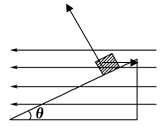问题
计算题
如图所示,一带电量为q=-5×10-3 C,质量为m=0.1 kg的小物块处于一倾角为θ=37°的光滑绝缘斜面上,当整个装置处于一水平向左的匀强电场中时,小物块恰处于静止状态.(g取10 m/s2):

(1) 求电场强度多大?
(2)若从某时刻开始,电场强度减小为原来的 ,求物块下滑距离L=1.5 m时的速度大小
,求物块下滑距离L=1.5 m时的速度大小
答案
(1) 150N/C(2) 1.35J
题目分析:受力分析:竖直向下的重力,水平向右的电场力,垂直斜面向上的支持力

(1)N*cos37°=mg ①
Eq=N*sin37° ②
联立得 E=(mg*tan37°)/q=150N/C
(2)运用正交分解法
mg*sin37°-0.5*Eq*cos37°=ma
解得 a=0.3g
由动能定理:
mg*L*sin37°+0.5*Eq*L*cos37°=Ek-0
解得 Ek=0.9*mgL=1.35J
点评:本题难度较小,注意重力和电场力做功与路径无关,与初末位置有关
